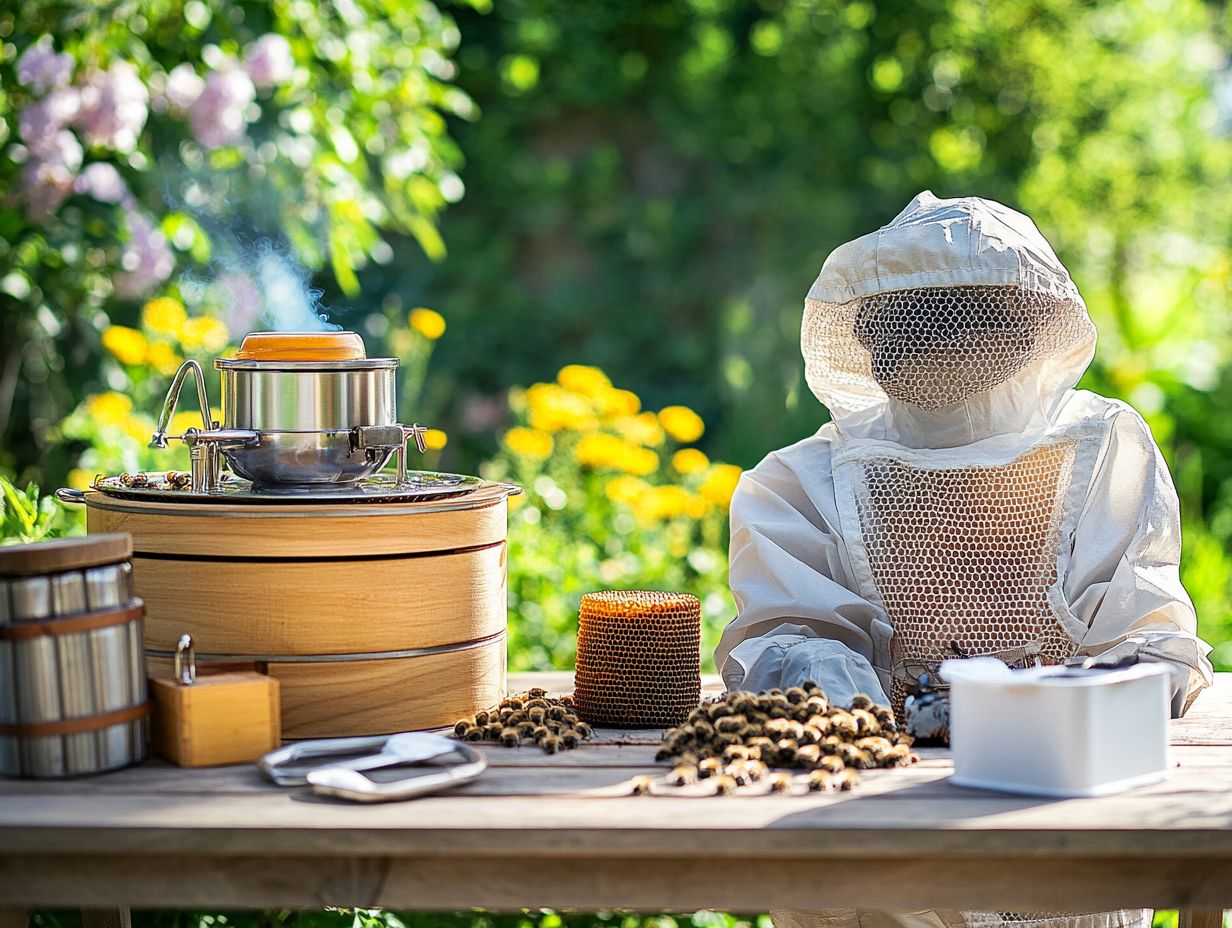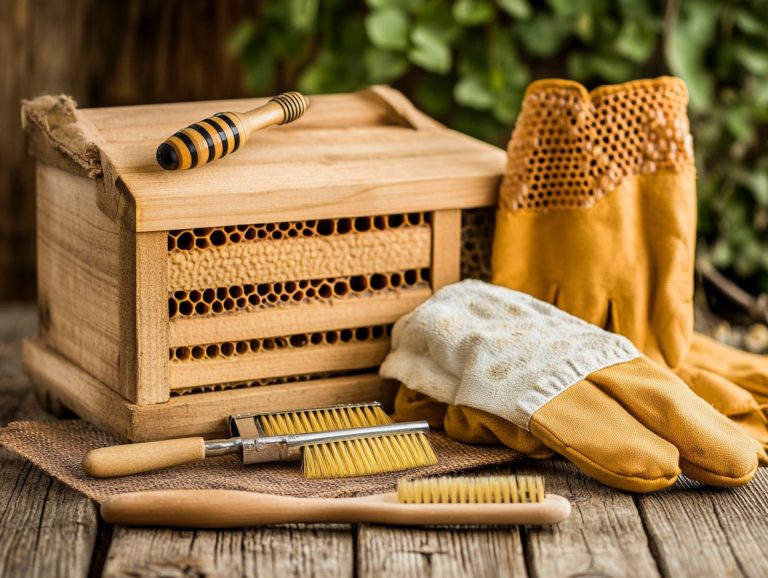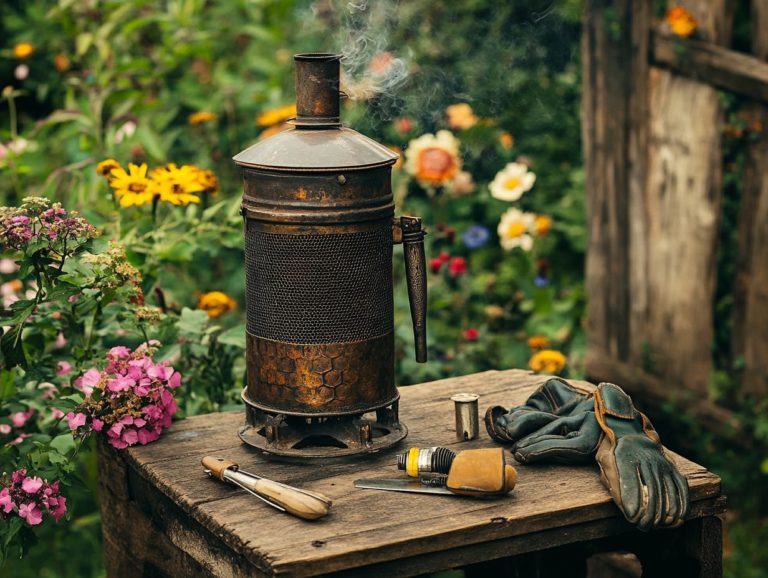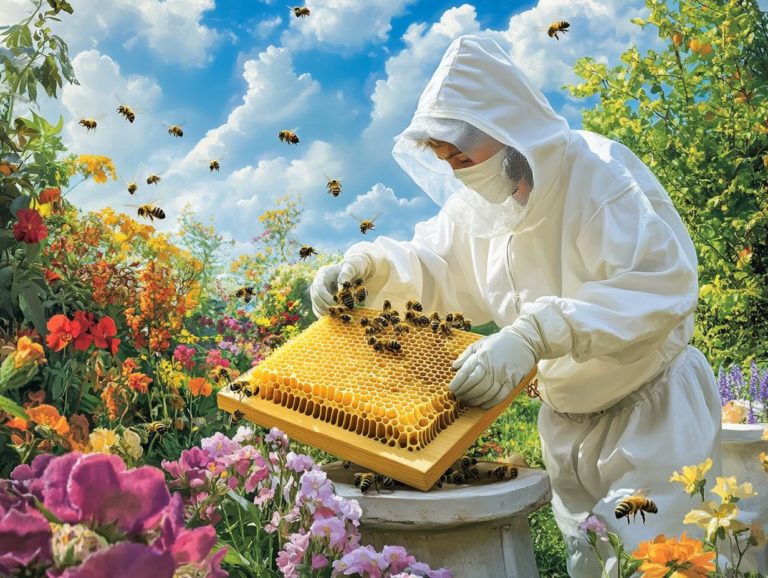The Science Behind Beekeeping Equipment Design
Beekeeping transcends mere artistry; it embodies a science grounded in the meticulous design of bee equipment.
Every component, from the hive’s architecture to the tools employed for upkeep, plays an essential role in nurturing vibrant honey bee populations and optimizing honey yields. This exploration delves into the importance of beekeeping equipment design, reflecting on the myriad factors that influence it, the ways in which hive configurations affect bee behavior, and the advancements in protective gear and tools.
From breeding traits to advanced hive designs, uncover how cutting-edge innovations are revolutionizing the landscape of beekeeping and shaping its future.
Contents
- Key Takeaways:
- Why is Beekeeping Equipment Design Important?
- The Hive: The Foundation of Beekeeping Equipment Design
- The Frames: Supporting the Hive and Honey Production
- The Protective Gear: Ensuring Safety for Beekeepers
- Essential Tools for Hive Management and Maintenance
- The Honey Extractor: A Key Component in Harvesting Honey
- The Future of Beekeeping Equipment Design
- Frequently Asked Questions
- What is the science behind beekeeping equipment design?
- Why is it important to understand the science behind beekeeping equipment design?
- How do beekeepers incorporate the behavior of bees into equipment design?
- What role do materials play in beekeeping equipment design?
- How has technology influenced beekeeping equipment design, including breeding systems?
- What are some key considerations when designing beekeeping equipment and incorporating breeding traits?
Key Takeaways:
Why is Beekeeping Equipment Design Important?
The design of beekeeping equipment plays a pivotal role in optimizing colony performance and enhancing honey production, as it directly impacts the health and productivity of honey bees. This design is particularly important for managing environmental conditions and reducing stressors, such as Varroa mites and other pests.
By integrating insights into bee behavior, you can create environments that foster essential traits like hygienic behavior and genetic diversity within your colonies. Experts like Dr. Marla Spivak and Gary Reuter are tirelessly exploring innovations in hive design, ensuring that you have access to the best practices in modern beekeeping. They also highlight the importance of breeding programs to enhance traits like disease resistance and Varroa mite management.
What Factors Should be Considered in Beekeeping Equipment Design?
When designing your beekeeping equipment, there are several crucial factors you’ll want to consider, such as environmental conditions, colony behavior, and specific needs related to traits like mite and disease resistance, especially in breeding systems.
These elements play a significant role in the overall success of your beekeeping ventures. For example, the temperatures and humidity levels in your area will dictate how your hives should be insulated or ventilated, which directly impacts the performance of your colonies and their resistance to diseases such as chalkbrood and American foulbrood.
By understanding the social structure and foraging behaviors of your bees, you can create environments that nurture their natural instincts, ultimately enhancing both productivity and well-being. Additionally, you must pay close attention to pests and diseases; your equipment should address the health requirements of the colony to ensure it can resist challenges like Varroa mites and other pathogens.
In the end, successful beekeeping is all about creating a harmonious synergy between the natural tendencies of your bees and the external conditions they encounter. Incorporating insights from breeding programs can also improve colony performance and genetic diversity.
The Hive: The Foundation of Beekeeping Equipment Design
The hive is the cornerstone of beekeeping equipment design, and it plays a crucial role in optimizing both colony performance and honey production. A thoughtfully designed hive enhances queen and drone production while fostering an environment that encourages genetic diversity among honey bees, particularly Apis mellifera and Apis cerana.
By incorporating features like queen excluders, you can effectively manage bee populations within the hive, leading to improved yields of prized products like comb honey. It’s essential that the design aligns with the natural behaviors of honey bees, promoting a healthy and thriving colony. Incorporating insights from institutions like the Cornell University and Washington State University can further improve hive design.
What are the Different Types of Hives Used in Beekeeping?
You’ll find several types of hives in the world of beekeeping, each tailored to various practices and preferences. These include the Langstroth hive, top-bar hive, and Warre hive.
Each type has its own benefits, particularly in breeding systems like open and closed systems. The Langstroth hive, with its design made of separate sections and movable frames, provides you with easy access and management. This makes honey harvesting and colony inspections a breeze.
This construction not only allows for optimal bee behavior but also supports a robust colony performance. It is particularly effective when considering breeding traits like the ability of bees to withstand pests called mites and disease resistance.
On the other hand, the top-bar hive takes a more natural approach, encouraging your bees to build their comb horizontally. Some beekeepers swear this leads to healthier colonies, although it may come with the trade-off of lower honey yields.
Then there’s the Warre hive, affectionately called the ‘people’s hive,’ perfect for those who love simplicity in beekeeping! It focuses on minimal intervention, which might resonate with those of you seeking a more sustainable beekeeping method. Just keep in mind that its unconventional structure could present some challenges when monitoring pests and productivity.
How Does Hive Design Affect Bee Behavior and Productivity?
The design of your hive has a profound impact on bee behavior and productivity. It shapes everything from foraging patterns to colony organization and overall health. The right design can also facilitate breeding programs that promote clean habits and genetic diversity.
Consider how structural elements such as the size of the entrance, the arrangement of frames, and ventilation play pivotal roles in your hive’s effectiveness. A well-designed entrance can facilitate optimal activity. Poor layout and airflow may inadvertently obstruct the bees’ natural instincts.
For example, ensuring proper ventilation can reduce moisture levels, supporting bee health and creating a thriving environment for honey production. Incorporating breeding traits like mite resistance fortifies the hive against pests.
Genetic diversity in your colony is key for resisting diseases and pests. These challenges can be magnified by subpar hive conditions. By grasping the connection between specific hive features and bee behavior, you can craft environments that not only bolster the survival of your bees but also enhance their efficiency in honey production.
This insight is crucial for breeding bees that can thrive against diseases and pests!
The Frames: Supporting the Hive and Honey Production

Frames are essential in supporting the hive structure and enhancing honey production. They enable bees to efficiently construct comb honey while also offering you, as a beekeeper, more streamlined options for managing the hive.
Proper frame design can also support breeding programs and improve overall colony performance.
What Materials are Used in Frame Construction?
Regarding frame construction for beekeeping, you ll find a variety of materials at your disposal, each bringing its own set of advantages and considerations. Institutions like the Canadian selection program and Danish breeding stock provide valuable insights into selecting the best materials for frames.
Take wood frames, for example. They excel in insulation and natural ventilation, making them a favorite among many beekeepers. With proper maintenance, they can endure several seasons. However, monitor them for rot or pest damage over time. Beeswax can also enhance the longevity and effectiveness of wooden frames.
On the flip side, plastic frames are lightweight and easy to handle, allowing for quicker hive management. Be mindful that they may not last as long in extreme temperatures and don t offer the same insulation benefits as wood. Purdue University Honey Bee Lab is improving plastic frames’ quality and functionality.
Then there are metal frames. While undeniably sturdy, they re not as commonly used. It s crucial to consider how the materials you choose affect not only the hive’s structural integrity but also the well-being of your bees and their honey production.
The type of material can significantly influence the hive’s ability to maintain a stable temperature, which is essential for maintaining a healthy colony and achieving optimal honey yields.
How Does Frame Design Impact Honey Production and Harvesting?
Frame design profoundly influences your honey production and harvesting efficiency, affecting how you access honey and manage your hives. Effective frame design can also enhance traits like hygienic behavior and disease resistance in breeding systems.
Innovations in frame construction can greatly streamline your entire harvesting process, aligning perfectly with the needs of both your bees and yourself. Advanced designs like removable frames and flow frames enable quicker honey extraction while keeping disruptions within the hive to a minimum. This approach alleviates stress on your bee colonies and boosts productivity, leading to more abundant honey yields. Insights from the USDA and APHIS can help refine these designs.
By incorporating lightweight materials and modular systems, you can enjoy easier handling and reduced physical strain during harvesting. Ultimately, this contributes to the overall health of your hive and promotes a more sustainable beekeeping practice. Performance evaluation of these systems can provide further insights into their efficacy.
The Protective Gear: Ensuring Safety for Beekeepers
Protective gear is your best friend for staying safe while beekeeping, offering essential defense against bee stings and the various hazards that come with managing hives. Don t take chances! Invest in high-quality gear to safeguard yourself as you work with these remarkable creatures. Beekeeper education on the importance of quality gear is crucial for safe and effective hive management.
What are the Essential Items in Beekeeping Protective Gear?
Essential items in your beekeeping protective gear include bee suits, gloves, and veils. These items are meticulously designed to safeguard you from potential bee stings and other hazards. Institutions like Minnesota Hygienic bees and the Canadian selection program provide valuable insights into the latest advancements in protective gear.
Choosing high-quality bee suits crafted from durable, breathable materials is vital for your comfort during long hours of work. These suits provide effective protection while allowing you flexibility and ease of movement, which is essential when navigating busy hives.
Protective gear also plays a role in breeding programs, enabling safe handling of bees during trait selection and performance evaluation.
Gloves are another critical component designed not just to shield your hands from stings, but also to maintain your ability to move your hands easily while handling equipment and honey bees. Opting for gloves made from thick yet flexible material will enable you to achieve a better grip and control, which is particularly important when dealing with pests like Varroa mites, which are tiny parasites that can harm bee colonies, and other challenges.
Veils, often overlooked, play a crucial role in protecting your face and neck. They help prevent the discomfort and distraction that can occur from buzzing bees. When selecting these protective items, prioritize a proper fit; ill-fitting gear can hinder your movement or leave areas of exposed skin, increasing the risk of bee-related injuries and exposure to environmental conditions.
Regular maintenance, such as cleaning and proper storage, will extend the life of your essential gear. Using high-quality materials like beeswax in maintenance improves the longevity of your equipment.
How Has Protective Gear Design Evolved Over Time?
The design of protective gear has undergone a remarkable transformation, with innovations aimed at enhancing safety, comfort, and functionality specifically for beekeepers. Advances in breeding traits and genetic diversity have also contributed to improved colony performance and equipment design.
This evolution can be traced back to the early, basic garments that offered little more than a flimsy barrier against bee stings. Over time, advancements in materials, such as lightweight, breathable fabrics and high-strength synthetic fibers, have been crucial in improving usability. These materials are especially beneficial in combating pests and diseases.
Today s beekeeping suits often boast reinforced stitching and mesh ventilation, granting you greater mobility while maintaining maximum protection. Features like flexible knee pads and integrated gloves have further refined your beekeeping experience. They enable you to work more efficiently and comfortably in your hives while keeping your safety firmly at the forefront. These advancements are crucial in promoting disease resistance and mite resistance within your colonies.
Essential Tools for Hive Management and Maintenance

Beekeeping tools play an essential role in enabling you to manage and maintain your hives effectively. Equipping yourself with the right tools ensures that you care for your colonies efficiently, which is crucial for maximizing honey production to its fullest potential. Utilizing tools like the queen excluder can enhance your ability to manage queen and drone production effectively.
What are the Essential Tools for Hive Management?
Essential tools for hive management include the smoker, hive tool, and bee brush. Each serves a distinct purpose in maintaining the health and productivity of your hive. Understanding the functions of these tools is crucial as you embark on your beekeeping journey.
Beekeeper education on the proper use of these tools can significantly impact overall hive health and honey production. The smoker plays a vital role in calming bees by masking alarm pheromones, allowing you to conduct inspections with greater safety.
The hive tool is your best friend, essential for prying apart frames and scraping away wax buildup, ensuring that the hive remains clean and accessible. The bee brush offers a gentle way to move bees off frames without causing them harm a crucial consideration during delicate tasks like honey extraction and comb honey harvesting.
As a new beekeeper, familiarize yourself with these tools and practice basic techniques to build your confidence. Always remember to smoke the hive before any inspection and handle the frames with care for a smooth and effective beekeeping experience.
How Has Tool Design Improved Efficiency and Effectiveness in Beekeeping?
Tool design has dramatically enhanced both efficiency and effectiveness in beekeeping. Recent innovations have brought forth advanced hive monitoring systems that deliver real-time data on temperature, humidity, and even bee activity.
This means you can make timely interventions when needed, ensuring the best care for your colonies. Performance evaluation of these systems can greatly improve colony behavior and overall hive health.
Imagine using ergonomic tools, like lightweight hive tools and specially designed suits, that make inspections feel like a breeze! These tools alleviate physical strain and enhance your safety by minimizing direct contact with bees during inspections.
These advancements not only streamline your management process but also lower the risk of bee-related injuries. With these improvements, you can concentrate on hive health rather than getting bogged down by laborious tasks, ultimately leading to increased honey production and enhanced overall colony vitality.
Selecting for traits like hygienic behavior improves colony performance.
The Honey Extractor: A Key Component in Harvesting Honey
The honey extractor stands as an essential instrument in your harvesting toolkit. It is carefully made to extract honey from the comb with remarkable efficiency. This tool ensures that the delicate structures of the bees remain largely intact, preserving the integrity of their hard work while you reap the sweet rewards of your labor.
Proper use of honey extractors also helps maintain the quality of the extracted honey, preserving its flavor and aroma.
What are the Different Types of Honey Extractors?
As you delve into the world of beekeeping, you ll discover a variety of honey extractors, including:
- Centrifugal extractors
- Radial extractors
- Tangential extractors
Each type is designed with distinct advantages to enhance your honey-harvesting experience. Innovations from renowned institutions like Purdue University Honey Bee Lab and Cornell University have greatly influenced honey extractor designs.
Centrifugal extractors spin frames filled with honeycomb, using centrifugal force to extract honey while keeping the comb intact. This makes them particularly well-suited for larger operations where efficiency is paramount.
Radial extractors extract honey from both sides of the frames simultaneously, streamlining the process and reducing the labor involved. If you’re working on a smaller scale, tangential extractors may be your best bet, as they extract honey from one side at a time, making them ideal for the more intimate beekeeper.
Your selection of extractor greatly impacts not just the efficiency of your honey extraction but also the quality of the final product. Honey extracted gently tends to retain its exquisite flavors and essential nutrients, allowing you to present your harvest in all its glorious richness.
Start your beekeeping journey today! Equip yourself with these essential tools and watch your hive thrive.
How Does Honey Extractor Design Affect Honey Quality and Yield?
The design of honey extractors is pivotal in determining both the quality and yield of your honey. This significantly influences the effectiveness of your extraction process. Utilizing equipment designed with insights from experts like Dr. Marla Spivak and Gary Reuter can greatly enhance your honey production.
A well-constructed extractor maximizes the amount of honey you can harvest. It also ensures that those delicate comb structures remain intact. This preservation is crucial, as any damage to the comb can lead to a decline in honey quality, negatively impacting its flavor and aroma.
Speed is another critical factor. Modern extractors come equipped with features that facilitate faster extraction without compromising quality. Innovations like variable speed controls and gentle spinning mechanisms have been engineered to enhance honey retrieval while safeguarding the integrity of the honeycomb.
Improved maintenance designs allow for easier cleaning and upkeep. This ensures your final product remains pure and free from contaminants. This is particularly important in preventing issues like American foulbrood and chalkbrood, which can compromise honey quality.
The Future of Beekeeping Equipment Design

Get ready! The future of beekeeping equipment is about to undergo an exciting transformation. It’s ready to embrace cutting-edge innovations and technology. This evolution aims to enhance sustainability within the beekeeping industry while tackling pressing challenges like bee health and environmental changes. Programs like the Canadian selection program and Danish breeding stock initiatives are paving the way for these advancements.
What Innovations and Advancements Can We Expect in Beekeeping Equipment Design?
Innovations and advancements in beekeeping equipment are set to transform your hive management practices. Technology plays a pivotal role in enhancing both productivity and bee welfare. Research from institutions like Washington State University and USDA APHIS is driving these breakthroughs.
Imagine leveraging emerging smart beekeeping technologies, like hives with smart sensors equipped with sensors. These tools are poised to revolutionize how you monitor your colonies. They provide real-time data on temperature, humidity, and hive activity, allowing for timely interventions that may prevent hive loss.
These groundbreaking innovations are vital for breeding systems, including both open and closed systems, to maintain genetic diversity and colony health. Enhanced monitoring systems are developing sophisticated algorithms to analyze bee behavior patterns, ultimately streamlining your management process.
Automated hive management tools, including robotic frames that monitor brood patterns and manage food supplies, promise to reduce your manpower needs while boosting efficiency. Such technologies can be particularly beneficial for breeding program management and performance evaluation.
Together, these innovations not only aim to improve the overall health of bee populations but also empower you with data-driven insights to enhance your operational strategies. Institutions like Cornell University and the USDA are at the forefront of developing these tools for better hive management.
Frequently Asked Questions
What is the science behind beekeeping equipment design?
Beekeeping equipment design is all about knowing how bees behave and what they need.
Why is it important to understand the science behind beekeeping equipment design?
Understanding the science of beekeeping equipment design means knowing how to best support our buzzing friends! By incorporating knowledge about Varroa mites and other pests, beekeepers can create equipment that is effective, efficient, and safe for both the bees and themselves. This can significantly improve disease resistance and colony performance.
How do beekeepers incorporate the behavior of bees into equipment design?
Beekeepers study the behavior of bees and their natural instincts, such as their tendency to build honeycombs in dark, enclosed spaces. This knowledge helps design equipment that mimics the bees’ natural environment.
It promotes their productivity. Insights from experts like Dr. Marla Spivak and Gary Reuter, who have extensively studied colony behavior, are often utilized in this design.
What role do materials play in beekeeping equipment design?
The materials used in beekeeping equipment must be durable, non-toxic, and able to withstand harsh weather conditions. The design must also consider the weight, texture, and scent of the materials, as these affect the bees’ behavior.
This includes considerations for both honey bees and Asian honey bees.
How has technology influenced beekeeping equipment design, including breeding systems?
Thanks to technological breakthroughs, beekeepers can now craft more precise, durable, and efficient equipment than ever before! For example, 3D printing has transformed the creation of hive components.
Sensors and data analysis have improved monitoring and management of bee colonies, enhancing colony performance and disease resistance.
What are some key considerations when designing beekeeping equipment and incorporating breeding traits?
When designing beekeeping equipment, the safety and comfort of the bees are paramount. The ease of use for the beekeeper and overall efficiency are also crucial factors.
It s vital to incorporate breeding traits like hygienic behavior and mite resistance. Don t overlook the cost, sustainability, and environmental impact of your materials and design choices!







